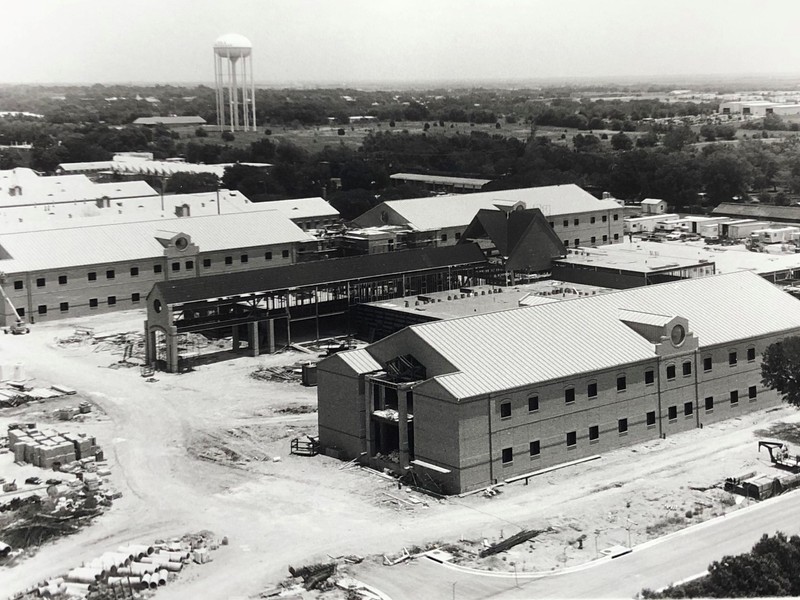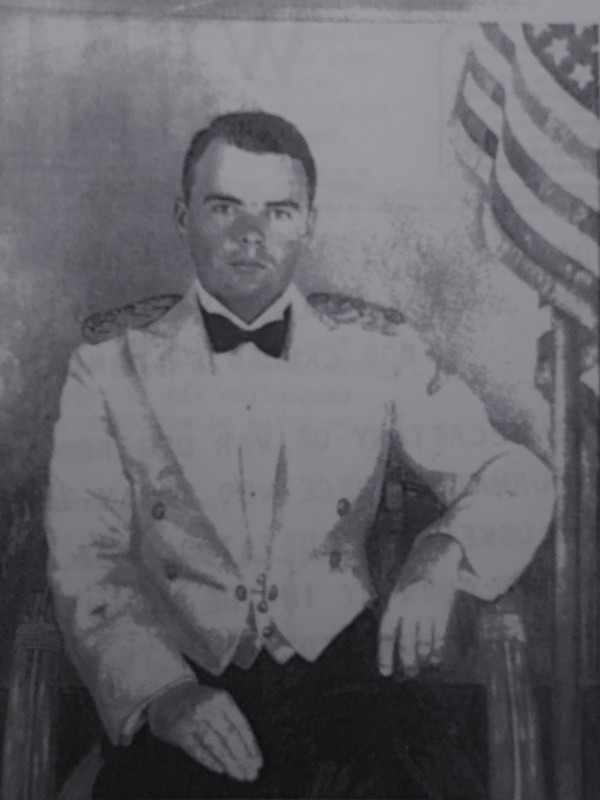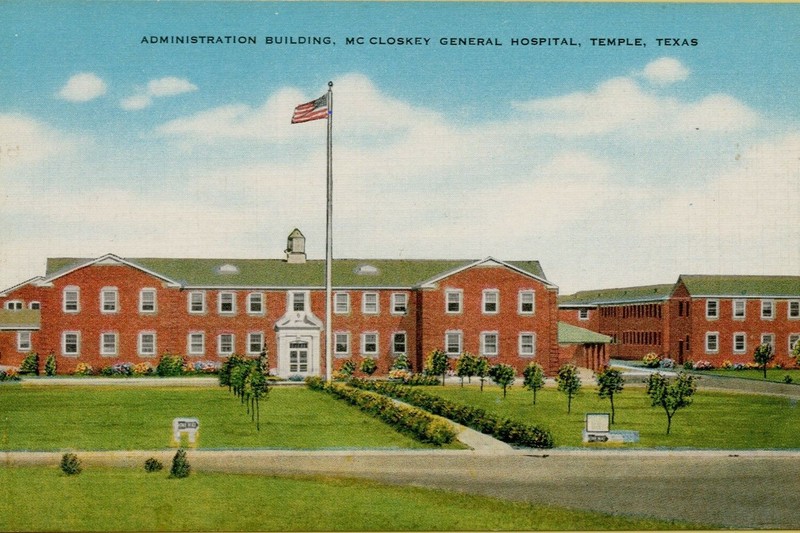US Army McCloskey General Hospital
Introduction
Text-to-speech Audio
When the Japanese struck Pearl Harbor in December 1941, the Army had a total of about 74,000 beds in hospitals in the continental United States (or Zone of Interior). During the next 18 months, a building program for new hospitals was started. By the peak patient load in 1945, there were a total of 132,000 beds.
During World War II, there were four types of hospitals in the Zone of Interior: general, regional, station, and convalescent. Generally speaking, general hospitals were named in honor of deceased military medical personnel. When Franklin Roosevelt proclaimed a ‘limited national emergency’ in 1939, the Medical Department of the US Army was only operating five general hospitals in the United States. When mobilization was announced, planning and expansion of hospitals was made and providing hospitals in the Zone of Interior became a necessity. Domestic construction of 10 general hospitals was approved on September 25, 1940.
The Veterans Administration Hospital in Temple as we know it now began its existence as McCloskey General Hospital in 1942.
Images
McCloskey Army Hospital under construction

James A. McCloskey, the hospital's namesake

Postcard of McCloskey Administration Building

Backstory and Context
Text-to-speech Audio
The Temple Chamber of Commerce formed a War Projects Committee to make a bid for having a hospital in Temple. Frank Mayborn, Dr. A.C. Scott, and Congressman W. R. Poage were active in Washington in supporting the choice of Temple. Other cities in Central Texas submitted bids, but Temple was chosen because it was close to several Army camps, transportation was good, and it had an established reputation as a medical center. During the Great Depression, the railroads cut salaries drastically and laid off workers. The ripple effect struck at the financial health of Temple hospitals which were dependent on paying patients. Bell County’s economy was stagnant by the late 1930s with little hope of recovery. Things were about to change.
The designation was announced in 1942 and immediate action was taken to acquire 216 acres of land on the city’s south side to build a 3,000-bed hospital. The Army notified Mrs. James A. McCloskey that an Army hospital would be built in Temple, Texas, and would be named for her husband. James A. McCloskey was the first medical officer killed in World War II. According to the architect on the project, the accumulated cost for the hospital was in excess of $25 million dollars.
As new Army general hospitals were activated early in 1942, it became obvious that specialists to staff them were limited in number. The solution lay in concentrating related specialties in one hospital and designating it a specialized treatment center. There were approximately 15,000 patients with major amputations in World War II. Early in 1943, five hospitals were designated as specialized centers for the treatment of amputees. McCloskey was one of these. The others were Bushnell General Hospital in Utah, Lawson General Hospital in Georgia, Percy Jones General Hospital in Michigan, and Walter Reed General Hospital in Washington, D.C. Later, two more amputation hospitals were added: Thomas M. England General Hospital in New Jersey and McGuire General Hospital in Virginia.
It took seven months to complete construction of McCloskey. It was a city within itself with 54 buildings all connected by covered and heated walkways. By the end of the war, there were 94 permanent buildings, 96 temporary buildings, a 9-hole golf course, swimming pool, tennis and handball courts, a baseball diamond, and a gymnasium.
McCloskey General Hospital was commanded throughout by one man, James A. Bethea. Prior to coming to McCloskey, Bethea served in the Panama Canal Zone and was chief of surgical services at Brooke Army Hospital at Fort Sam Houston. The hospital was dedicated November 4, 1942 with Congressman W. R. Poage delivering the principal address. The hospital opened with a staff of 140 doctors, 240 nurses, 400 enlisted men, and 850 civilian employees including technicians, clerks, janitors, gardeners, and others.
Not many people know that McCloskey was one of the few military hospitals in the nation with a full maternity ward. Wartime shortages and lack of housing meant that expectant soldiers’ wives had nowhere to deliver so Colonel Bethea set up the large maternity ward with as many as 15 babies born each day. The McCloskey maternity ward was also of special interest to Bethea, since his youngest daughter was born there during his tenure at Temple. Red Cross volunteers provided mothers and children with amenities and gifts. When word came from the Surgeon General to take care of maternity patients, Jaworski called Hillcrest Hospital and said, “Get everything ready for a complete delivery, and a few extra instruments. I don’t know what I’m going to do. I hadn’t delivered anyone since my first experience with the clinic in 1930. I came to Waco and took all the instruments I could, and got back to Temple at about two o’clock in the morning. In the meantime I looked over all my staff, and one of them, I found out was an obstetrician and gynecologist. We delivered our first baby within just a few hours after I brought the instruments, and no one was prouder than General Bethea. They immediately wired the Surgeon General that we had our first delivery at McCloskey.
What most people don’t know is that the doctors at McCloskey were pioneers in several fields including early ambulation, the use of penicillin, and the development of plastic eyes.
Jaworski said in his memoirs: “I started early ambulation in McCloskey with the okay and blessings of General Bethea. We received many hernia operations and many other operations. We got them up, if possible, the very next day. My patients were the happiest ones on the hall. Later on we had an opportunity to invite doctors from all over the area, and we gave them a talk on early ambulation, early care, early movement, and the use of elastic stockings which I also started."
In 1945, officials at McCloskey broke army secrecy to disclose full details of the development of a new plastic eye superior to the glass eyes manufactured in Germany. Major R. A. Mitchell, chief of the artificial eye lab at McCloskey stated, “Our new plastic eyes are superior in every way to the glass ones the Germans have been turning out for generations. They last a lifetime; they can’t be broken and they defy detection.” When the war broke out, it appeared that Black patches would be in order when the reserve of glass eyes ran out. No one in America could even duplicate the lifelike appearance of the Germany product. The old glass eyes varied slightly in shade from a real eye. Occasionally they would burst when the wearer walked from a hot room into the cold. They also pitted and had to be replaced as body acids wore on them. The new plastic eyes are indestructible and impervious to body acid. They are lightweight, move naturally with the real eye, and look very real. According to a story in the Milwaukee Journal, “every GI who loses an eye in combat gets a replacement made especially for him to his exact measurements.” General Mitchell stated, “We’ve whipped the Germans again—at their own game.”
McCloskey offered the first and only dietician program for enlisted women during World War II. There were eight mess halls on the campus. In March 1945 enlisted women were permitted for the first time to apply for assignment to the six-month apprentice dietetics training course. Five women were accepted and upon completion of the course, they were commissioned as Medical Department dietitians.
As time went on and evacuation procedures became easier, McCloskey received nearly all of the evacuees from the European theaters, as many as they could handle in the surgical field. There were times when 20 to 30 planes would land at the Temple airport during the day and some late in the evening bringing casualties directly from the small field hospitals. According to Jaworski, the mortality rate was remarkably low. McCloskey received 3 presidential citations and was complimented by the surgeon general. Dr. Jaworski was reassigned to the Philippines and left McCloskey in 1945.
Temple and McCloskey were also home to German POWs during the war. In August 1943, a group of wounded Italian and German soldiers were shipped to McCloskey from campaigns in Sicily and North Africa. The Germans and Italians did not get along so the Italians were sent elsewhere. The prisoner-of-war camp was located at the main campus of Temple College on the west side of South 1st Street. Victor Schulze wrote in his book that “there was a large barbed wire fence surrounding the compound with guards at the main gate.” Marvin Venable who was provost marshal of the militia stationed in Temple at that time said that all records about the POW camp were classified so few written records are available about the camp or prisoners. The 1944 annual report of the hospital indicated that POW wards existed in the hospital, and that 563 prisoner-of-war patients were admitted and 483 were discharged that year.
In 1945, noted sociologist, Oscar Lewis, wrote a series of articles based on a survey of rural conditions and home life in Bell County. One article appeared in the Belton Journal, October 11, 1945. He said, “The impact of the war on Bell County has been profound. Large- scale enterprises employing thousands of workers have come into or near the county since the war. The most important of these are Camp Hood, the McCloskey General Hospital, and the Bluebonnet Ordnance Plant in McGregor. These establishments… have created a great demand for labor and have drawn larger numbers away from the farms. It is estimated that approximately 400 farms have been abandoned since the war. Despite the movement away from the farms and the resultant farm labor shortage, crop acreage and production in 1944 was about equal to that of 1940. This was accomplished by increased mechanization and recruiting townspeople and soldiers’ wives to help with harvesting and cotton picking. Farmers are working harder and farmers’ wives are taking on a much greater share of the farm work. If Camp Hood and the McCloskey General Hospital continue to operate for many years after the war, as is expected, it will mean that a larger number of in-migrants will continue to come to the county, and this in turn will prolong the prosperity of the larger towns.
In 1946, the Veterans Administration took control of the hospital. In 1967, the hospital buildings were modernized and dedicated. In the early 1980’s the hospital became affiliated with Texas A&M University College of Medicine. By the mid-1990’s the center added a nursing home care unit, a $25-million clinical expansion project, a new domiciliary, and a satellite out-patient clinic in Austin. At that time, the hospital boasted a staff of more than 14,000 which included more than 80 physicians and an active community volunteer program. It had a capacity of 510 hospital beds, 120 nursing home beds, and 408 domiciliary beds. The number of annual hospital admissions at that time was more than 8,000 with 190,000 out-patient visits.
Cite This Entry
Karimkhani, Denise. "US Army McCloskey General Hospital." Clio: Your Guide to History. September 7, 2021. Accessed April 15, 2025. https://theclio.com/entry/139773
Sources
Karimkhani, Denise. For Us the Living: a History of US Army McCloskey General Hospital, Temple, Texas, 2020.

